Are you a Quiet Speculation member?
If not, now is a perfect time to join up! Our powerful tools, breaking-news analysis, and exclusive Discord channel will make sure you stay up to date and ahead of the curve.
Since the release of Eldritch Moon a few weeks ago, I’ve been obsessed with Spell Queller in Modern. The versatility and unique power of the card, along with the potential for synergies in deckbuilding and the complex lines of play it can sponsor, have been too enticing to resist. For the past few weeks I’ve been playing nothing else. In case you’re behind, two weeks ago I wrote an introductory piece discussing my philosophy behind my starting brew, and last week I wrote a more detailed piece discussing matchups and thoughts on a few individual cards. This week, I’ll be discussing variations; how the theory is applied to Magic archetypes in a general sense, and then how I applied the theory to my UW Blink brew specifically. Let’s get going!

The Baseline
For a “variation” to exist, a baseline must be established. In Magic, this baseline often takes the form of a “stock” list, or a generally agreed-upon consensus for what the base of a deck should be. Think UR Twin pre-banning, or Caw Blade in Standard. These types of archetypes are powerful, ever-present (by that I mean that they put up results almost independently of metagame conditions), and popular. For the most part, the power of these archetypes are proven, and the strengths and weaknesses well-known.
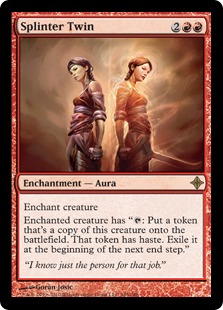 Most of the time, archetype variations are born out of a desire to shore up a specific weakness in the stock list, or to attack a specific vulnerability in a specific matchup or the broader metagame as a whole. We see the more benign form of variations frequently in Standard, as decks constantly adapt and modify their configurations to better attack opposing strategies or gain edges in specific matchups (particularly the mirror). The line between simple deck tuning and archetype variation can be blurry, but usually the distinction can be made depending on whether the deck’s Plan A (how the deck operates when given the freedom to do so) changes or stays the same. Mono-Black Devotion with 12 removal spells versus 8 doesn’t change gameflow that much, but Mono-Black Devotion with six ways to generate repeated card advantage in the main deck in place of six removal spells looks and plays entirely different.
Most of the time, archetype variations are born out of a desire to shore up a specific weakness in the stock list, or to attack a specific vulnerability in a specific matchup or the broader metagame as a whole. We see the more benign form of variations frequently in Standard, as decks constantly adapt and modify their configurations to better attack opposing strategies or gain edges in specific matchups (particularly the mirror). The line between simple deck tuning and archetype variation can be blurry, but usually the distinction can be made depending on whether the deck’s Plan A (how the deck operates when given the freedom to do so) changes or stays the same. Mono-Black Devotion with 12 removal spells versus 8 doesn’t change gameflow that much, but Mono-Black Devotion with six ways to generate repeated card advantage in the main deck in place of six removal spells looks and plays entirely different.
Often, an archetype can employ a variation but stays on-color to gain a surprise factor advantage. Around the time Delver of Secrets // Delver of Secrets was first starting to be played in Standard (in a metagame that contained Tempered Steel, UW Humans and Mono-Blue Illusions) I piloted a UW Control deck that played four Delver of Secrets // Delver of Secrets, but boarded them out after every game one. I placed 10th in my first SCG Open event ever, missing out on Top 8 on breakers. For fun, here is that list:
[wp_ad_camp_1]
UW Blade, by Trevor Holmes (10th, SCG Charlotte, 2011)
While this list looks pretty disjointed, my idea for the deck came about from a desire to do a few specific things. Leading up to that event, every article was talking about Delver of Secrets // Delver of Secrets, and every deck was packing their 75 full of ways to kill a Signal Pest and Phantasmal Bear. I wanted to employ the power of Delver of Secrets // Delver of Secrets alongside Swords as well, but also to make my opponent's removal as awkward as possible. 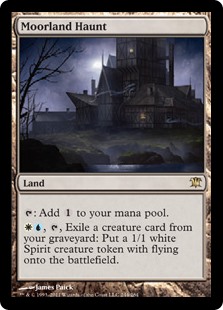 I accomplished this either by forcing them to spend whole cards to kill Moorland Haunt or Midnight Haunting tokens, or blanking them completely with Gideon Jura.
I accomplished this either by forcing them to spend whole cards to kill Moorland Haunt or Midnight Haunting tokens, or blanking them completely with Gideon Jura.
I won my "win and in" to top-eight on camera, but missed out on breakers. Sadly, video coverage of my feature match can no longer be found. Regardless, employing variations that either look or play similar to mainline archetypes, yet in reality do something completely different can be very successful given the right list and metagame conditions.
In Modern, we’ve seen examples of these types of variations multiple times over the course of the format's history. UR Splinter Twin, long considered the “Level 0” archetype in the format, splintered into three sub-variations for months a while back, with the old market share spread between Classic UR, Temur Twin, and Grixis Twin. Temur Twin sought to include Tarmogoyf to present a hard-hitting tempo attacker (and capable blocker) on turn two, which worked to negate multiple weaknesses present in the Classic UR version. Grixis Twin incorporated Kolaghan's Command, Tasigur, the Golden Fang and better removal in an attempt to increase overall card quality and decrease reliance on the combo and situational answers. 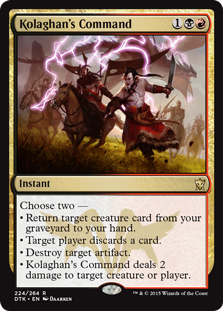 In each case, these variations grew out of a desire to address a targeted weakness.
In each case, these variations grew out of a desire to address a targeted weakness.
Before the Splinter Twin Trinity, brought about largely because of the printing of Kolaghan's Command, Twin had split before, this time into UR and Jeskai. In an attempt to increase overall card quality and gain access to more/stronger threats and answers, UWr Twin (as Jeskai was not a word at this time) cut most of the situational spells in exchange for Path to Exile, Restoration Angel, and Kiki-Jiki, Mirror Breaker. The results of this change were numerous and outside of the scope of this article, but in a general sense, each variation changes the texture of how every matchup plays, due to the differences inherent in how the deck is built and played. Access to more colors gives opportunity to include more powerful cards, but comes at a cost; three-color manabases are more painful against aggressive decks and inherently less consistent.
Identifying Our Weaknesses
For UW Blink, in my article last week I identified combo as an area of weakness that I was interested in shoring up. Wall of Omens, Kitchen Finks, and Path to Exile do great things, but when facing up against Ad Nauseam, Urza's Tower, Through the Breach they were hopelessly worthless.
Many viewers on stream suggested Meddling Mage as an answer for these specific matchups, and while I didn’t have any specific issues with the card, overall I wasn’t very impressed. Going back again to my overall philosophy for the deck, I wanted to play individually powerful cards that offered synergy when combined together, yet were still strong when played alone. Meddling Mage had some great applications in specific matchups, but I would really only be excited to play that card in the sideboard and I was interested in finding a way to improve my percentage against combo decks in the maindeck.
Thus, I turned to black.
Esper Blink, by Trevor Holmes
Adding a color to an archetype is something I resist doing at all costs, as I am usually of the opinion that if a problem can’t be solved in-archetype/in-color, then that is a strong sign I shouldn’t be playing that archetype/color combination to begin with. Most of the time (in three-color archetypes at least) splashing for a specific spell often isn’t worth the extra costs associated, 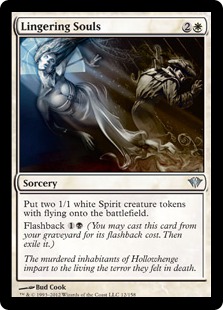 such as the changes required to the manabase and increased complexity in fetchland decisions. I get asked often about splashing Lingering Souls in Grixis Control, or adding white sideboard cards to Jund, and every time the answer is a definite no.
such as the changes required to the manabase and increased complexity in fetchland decisions. I get asked often about splashing Lingering Souls in Grixis Control, or adding white sideboard cards to Jund, and every time the answer is a definite no.
Still, going from two colors to three colors is “almost” free, and I say almost because it really isn’t free at all. However, fetch/shock manabases already contain “lost” points for the third color anyways (such as playing Scalding Tarn or Windswept Heath in UW) so the opportunity cost is lower than one might think. Really, the only major issues involved with adding a third color come about by making it difficult to play more basics or colorless sources, but with the right restrictions in place even this downside can be overcome.
Adding black gives us access to Tidehollow Sculler, Wasteland Strangler, and Thoughtseize, which are both more synergistic and more individually powerful than staying on-color for Meddling Mage. We’ll go through them one at a time.
- Tidehollow Sculler
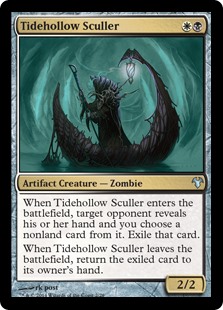 Sculler fills the hole of “power two-drop” that Snapcaster Mage filled on cost but couldn’t translate to curve. Snapcaster Mage is a “two-drop” in CMC, but without Gitaxian Probe in our deck we’re never playing it on turn two. In our straight UW list this was fine, as we had Goremand and Mana Leak to fill those spots, but in many games I found myself looking at a disjointed hand just wishing I could curve out with some other spell similar to Wall of Omens.
Sculler fills the hole of “power two-drop” that Snapcaster Mage filled on cost but couldn’t translate to curve. Snapcaster Mage is a “two-drop” in CMC, but without Gitaxian Probe in our deck we’re never playing it on turn two. In our straight UW list this was fine, as we had Goremand and Mana Leak to fill those spots, but in many games I found myself looking at a disjointed hand just wishing I could curve out with some other spell similar to Wall of Omens.
Tidehollow Sculler (while doing vastly different things than Wall of Omens) filled a hole in the deck and gave the archetype a ton of power against the field. Taking Supreme Verdict (or Path to Exile) against Jeskai Control makes our Spell Queller that much better, and the ability to nab a Karn Liberated from Tron, Cranial Plating from Affinity, Master of Waves from Merfolk, Become Immense from Infect, etc. is incredibly powerful and gives us a ton of much needed disruption to slow down our opponents. Our value gameplan remains the same, but where before we were looking to be more reactive with counterspells, now we’re just ripping their hand apart.
- Thoughtseize
 Supplementing Tidehollow Sculler in the maindeck, Thoughtseize in the sideboard gives us a lot more disruption for the combo matchups, as well as post-board games when our opponent is looking to interact and stop us from setting up our value engine. Where before we had Serum Visions, it was really just more of the same, as we were already drawing a bunch of cards with Wall of Omens, Flickerwisp, and Restoration Angel. Grabbing a removal spell (or hard-to-deal-with threat) to clear the way and buy time for our value engine ends up drawing us more than the one card the cantrip would have provided, and since making the swap I haven’t missed Serum Visions yet.
Supplementing Tidehollow Sculler in the maindeck, Thoughtseize in the sideboard gives us a lot more disruption for the combo matchups, as well as post-board games when our opponent is looking to interact and stop us from setting up our value engine. Where before we had Serum Visions, it was really just more of the same, as we were already drawing a bunch of cards with Wall of Omens, Flickerwisp, and Restoration Angel. Grabbing a removal spell (or hard-to-deal-with threat) to clear the way and buy time for our value engine ends up drawing us more than the one card the cantrip would have provided, and since making the swap I haven’t missed Serum Visions yet.
- Wasteland Strangler
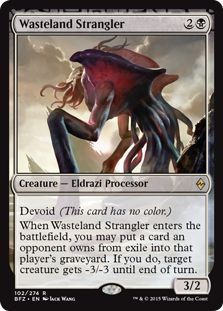 Finally, Wasteland Strangler joined the team as a way to take advantage of the numerous exile effects in place between Path to Exile, Tidehollow Sculler, and Spell Queller. While we don’t “need” Wasteland Strangler to make Tidehollow Sculler and Spell Queller good, having access to it gives us a lot more play and helps us in matchups where Queller/Sculler might not be as great (Jeskai Control, Jund Midrange).
Finally, Wasteland Strangler joined the team as a way to take advantage of the numerous exile effects in place between Path to Exile, Tidehollow Sculler, and Spell Queller. While we don’t “need” Wasteland Strangler to make Tidehollow Sculler and Spell Queller good, having access to it gives us a lot more play and helps us in matchups where Queller/Sculler might not be as great (Jeskai Control, Jund Midrange).
Games our opponent doesn't cast any creatures will downgrade Strangler to a mediocre Moriok Reaver. But in any other scenario, Wasteland Strangler will be rock-solid, killing a Dark Confidant that was drawing our opponent cards, shooting down a Signal Pest or Ignoble Hierarch, or finishing off an opposing Restoration Angel that was soaking up our own Angel’s attacks.
To make room for these spells, Snapcaster Mage was cut, and with him, most of the blue spells in the maindeck. In their place, we were able to maximize Aether Vial (it gets much better with these new creatures) and become a base BW deck splashing Spell Queller, at least in the maindeck. We are slowly shifting closer and closer to the BW Eldrazi Taxes list, but with a few key differences.
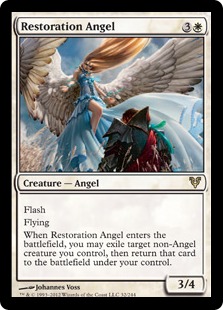 Not playing Eldrazi Temple, Thought-Knot Seer, and Reality Smasher might seem like we’re leaving power on the table, but we are gaining points in other areas instead. Wall of Omens, Restoration Angel, and Flickerwisp are all really good in the format right now, and access to all that card draw helps us find our reactive elements and sideboard spells more quickly and efficiently, while Eldrazi is often left to dump their hand and hope it's "good enough."
Not playing Eldrazi Temple, Thought-Knot Seer, and Reality Smasher might seem like we’re leaving power on the table, but we are gaining points in other areas instead. Wall of Omens, Restoration Angel, and Flickerwisp are all really good in the format right now, and access to all that card draw helps us find our reactive elements and sideboard spells more quickly and efficiently, while Eldrazi is often left to dump their hand and hope it's "good enough."
Conclusion
Don’t forget that this whole archetype is an exercise in determining how good we can make Spell Queller in Modern. I’m under no delusions here and understand that Eldrazi is the more defined archetype with a much more successful pedigree. Still, I like where the archetype is going and I feel like it’s getting better and closer to a great list with every match I play.
Spell Queller continues to put our opponent in awkward situations, and I’m still enjoying crafting the game to a state where our opponent is forced to walk removal straight into our Flickerwisp. Now that we’ve added Wasteland Strangler, the increased potential for blow-outs, two-for-ones, and even three-for-ones has me itching to fire up another match. Which I think I’ll do right now! If you’re interested in learning more about the deck, or have any opinions/thoughts, let me know in the comments below and stop by my stream! Thanks for reading and I’ll see you next week!
Trevor Holmes
The_Architect on MTGO
Twitch.tv/Architect_Gaming
Twitter.com/7he4rchitect




So bw death and taxes cutting arbiter and splashing blue for queller. Do not believe this is an upgrade, you just took an existing deck and cut one of its strongest cards to make your manabase crappier and play a less situational card.
At least uw with meddling mage is doing something different than an existing deck already does, and vialing in a mage when they bolt your queller is reasonable synergy (name the card queller was holding).
Wescoe seems to have a decent UW Hatebears/D&T deck with queller and arbiter in the same deck.
I’ve been meddling with a BW Blink version very similar to this. The new Liliana has proved great in the archetype due to how easily she is reset and protected. Also, her plus helps deal with go-wide strategies, which the deck feels weak to. I’m not sure she’d fit in a three-color manabase, but I thought I’d suggest it.
Hi! I really like your list. It’s actually very similar to something I played for a little while about two or three weeks ago now. I’ve been playing an Esper Tempo shell for a little while and ended up leaning towards a lower creature and land count with the extra spaces being filled by cheap counters like Spell Snare or Spell Pierce. Pierce in particular is very good against those pesky combo decks, and because you’re presenting an appreciable clock with cards like Spell Queller and Wasteland Strangler the conditional counters never feel too out of their depth.
One card that’s proved to be exceedingly (and surprisingly) strong in playtesting is Reflector Mage. I know it seems clunky but particularly in a deck with Aether Vial it’s a really solid answer to combo decks and can disrupt creature based combo exceedingly well. Not to mention the huge effect it can have against creature based aggression by blinking large threats at instant speed then blocking an X/2 such as Goblin Guide. Aether Vial really makes it fantastic. With the addition of blink shenanigans it’s an effect you can exploit over and over again whilst simultaneously pressuring the opponents life total.
My deck is here if you’re interested:
http://tappedout.net/mtg-decks/spell-strangler-developing-competitive/
I’d be really keen to hear your thoughts and any further opinions. I’m a huge advocate for the Spell Queller and Wasteland Strangler synergy and I really want to explore all the possibilities that exist to settle on the shell that feels the most solid!
It’s crazy I’ve been playtesting vs almost this exact list. (I’m in a grixis delver variant)
I can vouch for the very unpleasant feeling of sitting across from this. Really you only beat it if it stumbles or draws very badly.
Or if you draw godlike. It feels strongly favored against almost anything. Breach still seems really rough as your clock isn’t the fastest in the world and damn near everything dies to valakut triggers, plus queller is much less useful.
Still though. Great list!
I’ve been following your UW Blink articles/stream, and, amusingly, I just shifted to a very similar, more creature-focused (no Snap), Esper build. I wanted to add to your Strangler section that it becomes noticeably better when run with Wall of Omens. In matchups where your opponents aren’t casting creatures, being able to Flickerwisp a non-creature permanent into Strangle your own Wall is a very useful way to deal with urza/manlands or planeswalkers without sacrificing a creature to change the flicker into permanent removal. I’ve used it a number of times so far, and it’s been really useful.
I’d also add that I have yet to regret running 2 Worship in the sideboard. The card seems great right now.
I’m trying a few Thraben Inspector to even out my CMC’s, and I’ve been pleased so far. May not be worth it in the end, but it improves your T1 play-count and also makes you feel better about hands with strong 3-drops (with and without vial) since it’s a single card that provides at least some form of T1 and T2 play.
I’ve also been testing out Thraben Inspector for the same reasons (in a Wb blink variant) – sort of as Wall of Omens 5-6. So far liking the card draw. However, I did start with 4 and cut down to 2 as it’s an underwhelming body by itself, but it’s good for smoothing out the curve and providing a speed-bump vs. aggro decks.
Great point about Strangler on Wall! I don’t think that’s ever come up for me, but I’ll keep it in mind for when it does. I know anytime I can successfully Strangle my opponent’s exiled card and take out a creature it’s usually game over. Sadly, with Wb, I’m struggling with the spell-based combo decks (though beating mostly everything that tries to win via beat-down).